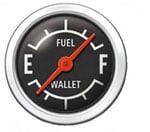 The 1st May new fuel subsidy system expected to be announced in March this year will likely involve those who qualify for subsidies only having a certain amount of litres of subsidised fuel a month. If you use beyond that allocated amount, you will have to pay the full price for your fuel.
The 1st May new fuel subsidy system expected to be announced in March this year will likely involve those who qualify for subsidies only having a certain amount of litres of subsidised fuel a month. If you use beyond that allocated amount, you will have to pay the full price for your fuel.
The amount of litres to be given is said to be between 200 to 300 litres per vehicle and if you have multiple vehicles, you will only get 1 car’s worth of subsidised fuel. I think it would be interesting to set up a poll and see how much of fuel you use every month.
I easily refill my car about 6 to 7 times a month or more because I travel alot, and each refill is about 65 litres. That would peg my usage at about 400 to 450 litres per month, which means if I qualify for the full 300 litres of subsidy (hypothetically), I would have to pay the full price for my remaining 150 litres of fuel.
Assuming a subsidy of 50 sen per litre – that’s about RM75 extra a month. But then of course, since there is word that engine capacity is going to be taken into consideration, even though my daily driver’s engine capacity is of less than 2,000cc, because I own an old E30 with a 2.5 litre engine that I want to restore, I will probably not qualify for any subsidies.
What’s your story? Share your petrol/diesel consumption pattern with all of us here, and perhaps with luck some relevant people in the ministry can observe your comments and it can be taken into consideration. Let’s try to be constructive as well as keep to the topic for this particular post’s comments.
So – how much fuel in terms of litres do you consume a month? Do you expect that you’ll qualify for subsidies? Vote in the poll below and share your story in the comments section.
[polldaddy poll=2739607]
Looking to sell your car? Sell it with Carro.


AI-generated Summary ✨
Comments indicate that many Malaysians are concerned about the fairness and practicality of the new fuel subsidy system, which limits fuel to around 100-150 liters per month, affecting those with larger engines or higher consumption. Several have questioned how the system will be implemented, fearing corruption, logistical issues, and increased queues. Many suggest that instead of targeted subsidies, the government should remove subsidies altogether and use the funds for public transportation or other social programs. There’s a common frustration that the subsidy system may benefit the rich and cronyism, while middle and low-income groups may suffer due to higher costs and limited allocations. Overall, sentiments are largely negative, citing inefficiency, lack of planning, and skepticism about the government’s ability to fairly and effectively manage fuel subsidies.